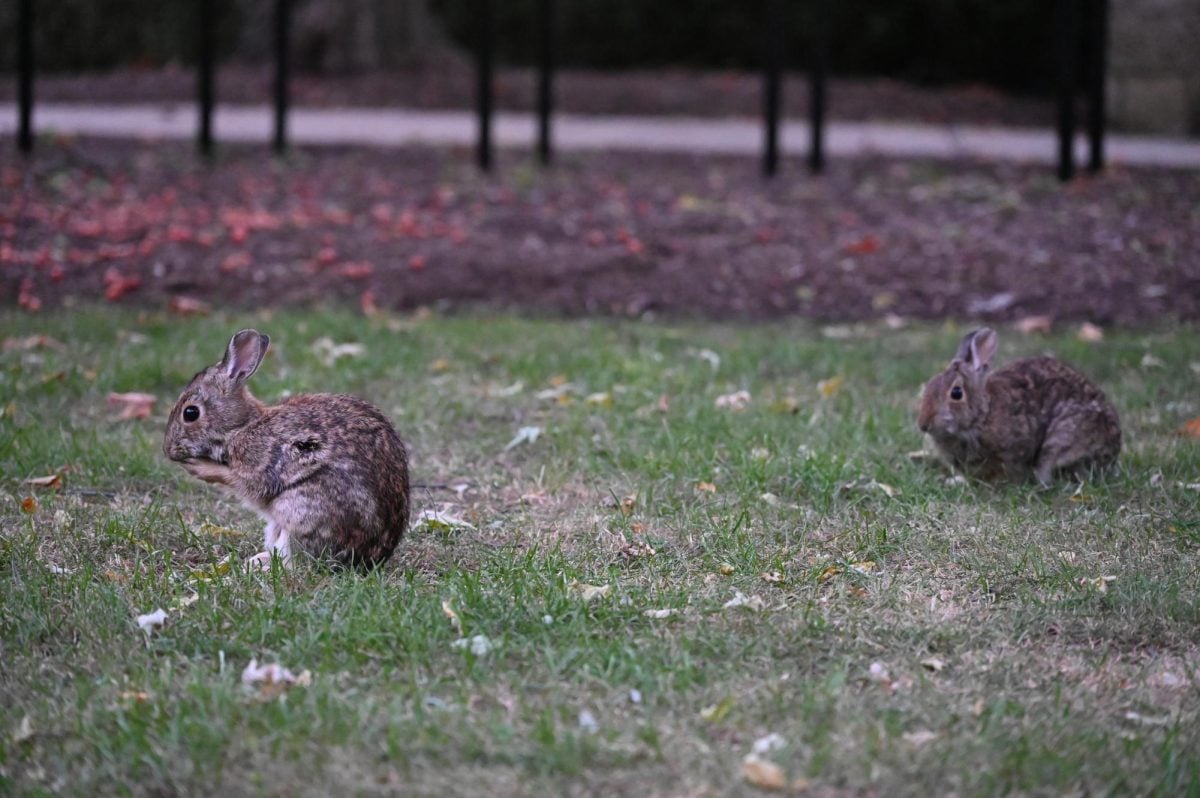Northwestern’s rabbits are everywhere. Lounging in grassy spaces, munching on carefully planted tulips and crocuses, chasing each other around the sorority quad, hopping across sidewalks and, in the case of one litter of babies, even curling up in flowerpots. Cute and highly photogenic, it’s no surprise they’re a key aspect of campus culture.
“Just seeing the bunny rabbits around honestly really makes my morning and night,” said Annabelle Sweet, a Bienen sophomore who walked past several sorority quad bunnies last spring. “They’re just eating and hopping around, and they’re really, really cute.”
The rabbits’ favorite nibble? “The Purple Dome Aster,” NU groundskeeper foreman Stephen Camburn said. “It’s one of our primary plants that we utilize for Northwestern colors.”
Eastern cottontails, the species of rabbit native to the area, can wreak havoc on campus landscaping, even in the winter — when there’s little else to nibble on, they may strip the bark off of trees and shrubs.
Camburn has seen a noticeable increase in the rabbit population in his 36 years at NU. “I would say that over the last probably five to six years, it’s been much more of a problem,” he said. He theorized that reduced predator populations, combined with milder winters, have caused the population explosion.
To protect the plants and landscaping, Camburn has a few tricks up his sleeve. He tries to plant flora that rabbits tend to avoid, such as plants belonging to the genus Allium, which includes many onion-like species. But the rabbits have developed a taste even for alliums, so he applies a peppery, spicy deterrent to the most visible flower beds.
Besides predators and pepper, the rabbits face another challenge: well-meaning bunny enthusiasts.
“Rabbits are one of the most commonly unintentionally kidnapped baby animals,” said Stephanie Touzalin, the wildlife education supervisor at the Willowbrook Wildlife Center in DuPage County. According to Touzalin, the center sees between 1,300 and 1,800 rabbits each year, many injured by vehicles and dogs, but also babies taken from nests by concerned animal lovers.
Usually, wild animals cope well on their own without human intervention. Even if a rabbit nest appears abandoned, the mother is typically nearby, taking care of her young at night.
Wildlife biologist Chris Anchor, who leads wildlife management in the Forest Preserves of Cook County, warns that rabbits can carry tularemia, a zoonotic (transferable from animal to human) disease which, in rare cases, can be fatal to humans. But Anchor estimated there are no more than 12 Illinois cases per year; the rate of transmission is “extremely low,” he said, and only occurs through close contact.
Sometimes, however, it’s the wildlife that comes a little too close for comfort on campus. Last spring, a squirrel was an uninvited guest in a Sargent Hall utility room. Outside the Patrick G. and Shirley W. Ryan Center for the Musical Arts, a red-winged blackbird is known to defend its nest by dive-bombing passersby. A raccoon christened “Wendy” regularly forages through trash cans by The Rock.
But it’s the bunnies that have developed a following among students. “11 bunnies in one photo!!! Is this a record??” one user posted last spring in the “nu bunny watching” chat on the messaging platform GroupMe. The chat boasts over 1,500 users.
“There’s a place where people just share all their pictures of wildlife. Sweet!” said SESP sophomore Tyler Moyer, who joined the chat in early April. “Bunnies and wildlife are a huge plus on campus.”
But the chat has also been subject to trolling, with a user posting a video of a goose being hunted and mauled by an alligator. Another user posted sexually suggestive content. The posts were taken down and the users responsible removed, but the incidents rattled the chat.
Fortunately, the haters haven’t stopped wildlife enthusiasts from sharing their best snapshots.
“I never get sick (of stopping and taking photos),” Moyer said. “It’s just a real treat to see them on campus.”
Email: [email protected]
X: @sashadm27
Related Stories:
— Meet the NU groundskeeping team
— Students create group chat to document rabbit sightings around campus






